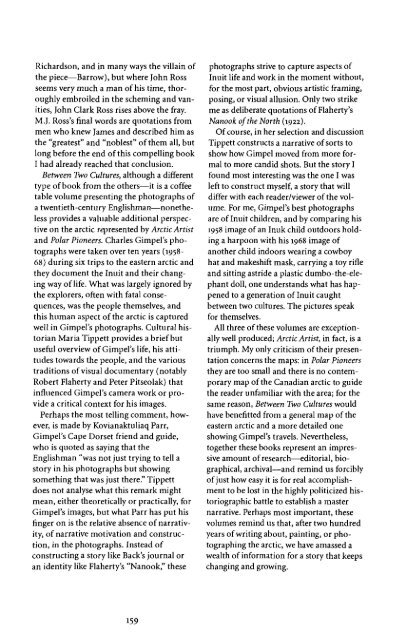Jean Rivard - University of British Columbia
Jean Rivard - University of British Columbia
Jean Rivard - University of British Columbia
You also want an ePaper? Increase the reach of your titles
YUMPU automatically turns print PDFs into web optimized ePapers that Google loves.
Richardson, and in many ways the villain <strong>of</strong><br />
the piece—Barrow), but where John Ross<br />
seems very much a man <strong>of</strong> his time, thoroughly<br />
embroiled in the scheming and vanities,<br />
John Clark Ross rises above the fray.<br />
M.J. Ross's final words are quotations from<br />
men who knew James and described him as<br />
the "greatest" and "noblest" <strong>of</strong> them all, but<br />
long before the end <strong>of</strong> this compelling book<br />
I had already reached that conclusion.<br />
Between Two Cultures, although a different<br />
type <strong>of</strong> book from the others—it is a c<strong>of</strong>fee<br />
table volume presenting the photographs <strong>of</strong><br />
a twentieth-century Englishman—nonetheless<br />
provides a valuable additional perspective<br />
on the arctic represented by Arctic Artist<br />
and Polar Pioneers. Charles Gimpel's photographs<br />
were taken over ten years (1958-<br />
68) during six trips to the eastern arctic and<br />
they document the Inuit and their changing<br />
way <strong>of</strong> life. What was largely ignored by<br />
the explorers, <strong>of</strong>ten with fatal consequences,<br />
was the people themselves, and<br />
this human aspect <strong>of</strong> the arctic is captured<br />
well in Gimpel's photographs. Cultural historian<br />
Maria Tippett provides a brief but<br />
useful overview <strong>of</strong> Gimpel's life, his attitudes<br />
towards the people, and the various<br />
traditions <strong>of</strong> visual documentary (notably<br />
Robert Flaherty and Peter Pitseolak) that<br />
influenced Gimpel's camera work or provide<br />
a critical context for his images.<br />
Perhaps the most telling comment, however,<br />
is made by Kovianaktuliaq Parr,<br />
Gimpel's Cape Dorset friend and guide,<br />
who is quoted as saying that the<br />
Englishman "was not just trying to tell a<br />
story in his photographs but showing<br />
something that was just there." Tippett<br />
does not analyse what this remark might<br />
mean, either theoretically or practically, for<br />
Gimpel's images, but what Parr has put his<br />
finger on is the relative absence <strong>of</strong> narrativity,<br />
<strong>of</strong> narrative motivation and construction,<br />
in the photographs. Instead <strong>of</strong><br />
constructing a story like Back's journal or<br />
an identity like Flaherty's "Nanook," these<br />
photographs strive to capture aspects <strong>of</strong><br />
Inuit life and work in the moment without,<br />
for the most part, obvious artistic framing,<br />
posing, or visual allusion. Only two strike<br />
me as deliberate quotations <strong>of</strong> Flaherty's<br />
Nanook <strong>of</strong> the North (1922).<br />
Of course, in her selection and discussion<br />
Tippett constructs a narrative <strong>of</strong> sorts to<br />
show how Gimpel moved from more formal<br />
to more candid shots. But the story I<br />
found most interesting was the one I was<br />
left to construct myself, a story that will<br />
differ with each reader/viewer <strong>of</strong> the volume.<br />
For me, Gimpel's best photographs<br />
are <strong>of</strong> Inuit children, and by comparing his<br />
1958 image <strong>of</strong> an Inuk child outdoors holding<br />
a harpoon with his 1968 image <strong>of</strong><br />
another child indoors wearing a cowboy<br />
hat and makeshift mask, carrying a toy rifle<br />
and sitting astride a plastic dumbo-the-elephant<br />
doll, one understands what has happened<br />
to a generation <strong>of</strong> Inuit caught<br />
between two cultures. The pictures speak<br />
for themselves.<br />
All three <strong>of</strong> these volumes are exceptionally<br />
well produced; Arctic Artist, in fact, is a<br />
triumph. My only criticism <strong>of</strong> their presentation<br />
concerns the maps: in Polar Pioneers<br />
they are too small and there is no contemporary<br />
map <strong>of</strong> the Canadian arctic to guide<br />
the reader unfamiliar with the area; for the<br />
same reason, Between Two Cultures would<br />
have benefitted from a general map <strong>of</strong> the<br />
eastern arctic and a more detailed one<br />
showing Gimpel's travels. Nevertheless,<br />
together these books represent an impressive<br />
amount <strong>of</strong> research—editorial, biographical,<br />
archival—and remind us forcibly<br />
<strong>of</strong> just how easy it is for real accomplishment<br />
to be lost in the highly politicized historiographie<br />
battle to establish a master<br />
narrative. Perhaps most important, these<br />
volumes remind us that, after two hundred<br />
years <strong>of</strong> writing about, painting, or photographing<br />
the arctic, we have amassed a<br />
wealth <strong>of</strong> information for a story that keeps<br />
changing and growing.<br />
159

















